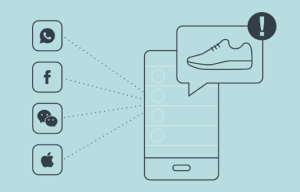In this article:
You’ve heard about chatbots. Have you trained your first one yet? Thinking you might want to give it a try?

If so, you have company (if not, check out this guide and you’re up to speed in no time). More and more businesses are discovering conversational marketing — and at Chatlayer.ai, we couldn’t be happier. Beginning of Q2 we announced that Chatlayer.ai had been acquired by Sinch, the cloud communications leader that serves 8 out of 10 of the largest US technology companies with voice and messaging solutions. Today I’ll bring you up to speed on how as a team, we’re boosting voice and messaging capabilities for marketing professionals with virtual agents powered by Artificial Intelligence (AI).
Conversational marketing was born out of several trends in digital communication. An important one is rich media. Twenty years — which is to say, an eternity — ago, a text meant 160 ASCII characters. More recently, rich messaging has enabled marketers to add emojis and website links to their SMS communications. Now it is time to make the next step. We can call it a revolution if you like.

The true revolution lies in turning a one-way message into two-way interaction
Text messages occupy their recipients’ attention for about three seconds. But if you can turn that brief blast into an ongoing conversation, you might have up to two minutes to interact with this potential customer. That’s 40x times the attention lifespan of a one-way message. This is any CMO’s dream (See this blog by our colleagues from Sinch for Marketing).
A two way conversation through a chatbot has up to 40x times the attention lifespan compared to a one-way message. This is any CMO’s dream.
It’s also much more personal. As the AI technology of natural language understanding (NLU) matures, algorithms can be trained, easily and straightforwardly, to understand the language of your customer and respond accordingly. We’ve already seen chatbots take hold in the area of customer care and contact centers. But that’s only the beginning; why would you want to post an ad banner that takes a blunt guess at what prospective customers might find interesting, when you can use technology like Chatlayer.ai to talk to people upfront and guide interested parties through your offerings? (See e.g. here how European telco Proximus uses chatbot ‘Alix’ to boost conversion in new mobile subscribers).
The live chat paradox
We’re often asked the question: isn’t live chat more effective? Not necessarily. Let’s say you’re a consumer sitting at home thinking about buying a pair of sneakers. You go to the (presumably technologically cutting-edge) website of one of the global sportswear brands in order to get your questions answered about sneaker size, color, and availability. And, seeing a live chat window on the site, you click in and say ‘Hello.’
Great for the global sportswear company, right? Well, when someone initiates a live online chat like this, a response only comes back quickly enough to start a conversation 10% - 15% of the time. A study points out it takes on average 2 minutes and 40 seconds to respond. Often even up to 9 minutes. That’s a big problem. Your customer is way gone by then!
Brands will become friends
But what if that exchange takes place on WhatsApp or Facebook or WeChat or Apple Business Chat? Once you say ‘Hello’ on one of those platforms, the sportswear brand will appear among your friend lists. So when you’re checking your messages, maybe you’ll notice them and think, ‘Oh yeah, I was ordering sneakers.’ Moving the chat into the customer’s preferred social channel makes it much likelier that the conversation will happen vs an online live chat, and brands are becoming aware of that. Many of the marketers we talk to are already using chatbots for conversational marketing, and many more of them are thinking about it.

Conversational marketing helps voices be heard
Another aspect of conversational marketing that we see forward-looking brands embracing is the importance of language. A global company doesn’t want to create and manage a separate marketing plan for each language or country; they’d much rather offer one experience that’s aligned everywhere. But until recently, it took enormous resources to train virtual agents in specific languages, which meant that companies developing chatbots could only realistically service the largest markets. As a result, chatbots were primarily English-based, with some Chinese and Spanish projects thrown in. Not great if you speak any other language (that’s still 70% of the world’s population), or want to reach consumers who do.
But as machine learning technology matures, chatbots are going multilingual. At Chatlayer.ai, we’ve developed a language-independent platform that you can configure in up to 125 languages — in text, rich media, and even voice.
Voice is the future (check out this guide to learn more). There are many millions of people all around the world who might want to buy sneakers from that sportswear brand but aren’t familiar with apps and other mobile technology. Five years ago those consumers who weren’t ‘digitally adopted’ were lost to online marketing.
Today, a voice-enabled chatbot that understands natural language, adapts to any channel, and communicates by speaking out loud can reach more or less anyone in the world.
Sound difficult to get launched? It isn’t. We made the Chatlayer.ai platform as buildable as possible. It is still generally true that - depending upon the study - between 30%- 70% of today’s IT projects fail (see e.g. this article by CIO.com). That’s a terrible but unsurprising figure. Lots of companies invested in virtual agents a few years ago. Most of these projects didn’t deliver. Why not? Because they became IT projects.
CMOs don’t want IT projects, they want solutions
Don’t get me wrong — I love ITers. They’re beautiful people. I love having beers with them and without them we wouldn’t have this beautiful platform that our clients so love. But for conversations that engage customers you have to bring your technology to the business people, the marketers, the salespeople; the folks who actually understand what the customer wants because it is their job to listen to them 100% of their day. We don’t want projects built on Chatlayer.ai to fail, so we made sure to build a product that a CMO and her/his team can use without the need of an IT project. Chatlayer.ai is a low-code (or even no-code) platform whose products you can have up and running in just a few days. We’ve seen a lot of brands that have been able to adopt our technology almost overnight with limited resources.

Our customers’ successes inspire us and keep us moving forward
Over the past few generations people’s interfaces with technology have narrowed but become steadily more human. Half a century ago you had to code in a computer language in order to make a computer do anything. Then you had interfaces, emails, SMS. Then smartphones with mobile apps. Now you can speak to software like you would to a human and it responds.
That’s a huge evolution, and we’re still in the early stages. At Chatlayer.ai we’re excited to help empower marketers to initiate genuinely two-sided relationships with their consumers, and if you’re interested in learning more, grab a virtual coffee with us. Let’s see where the conversations take us.
Article by Rick van Esch - CEO of Chatlayer.ai - let’s connect



